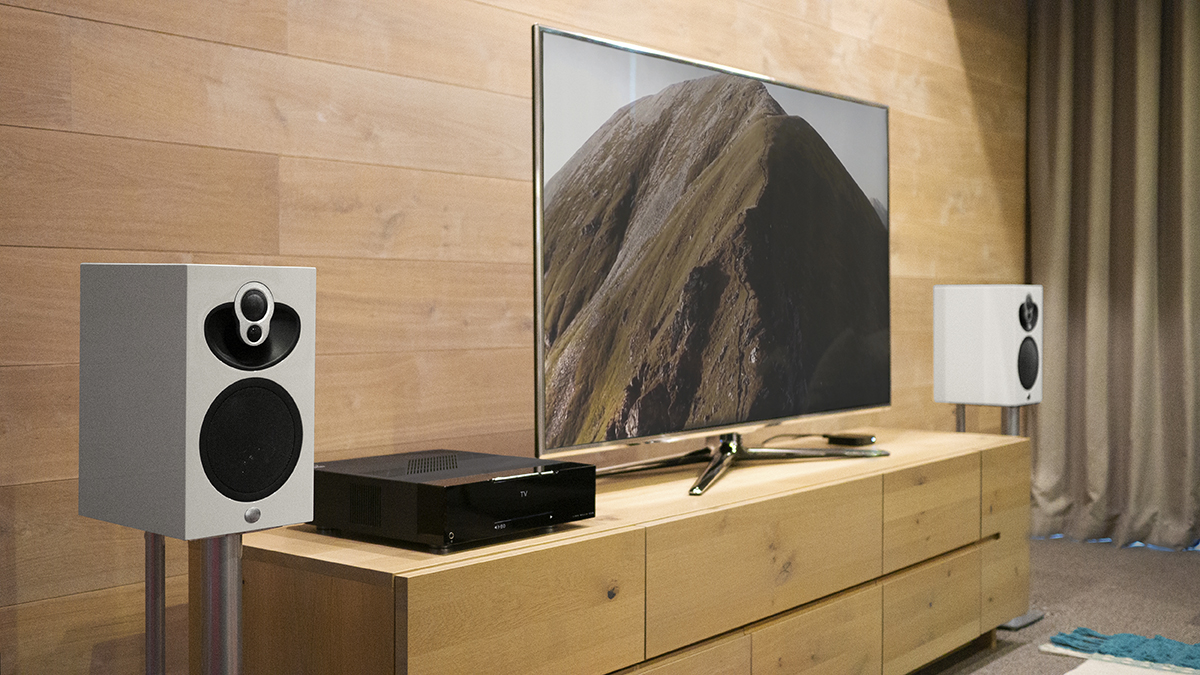REVIEW: LINN MAJIK DSM – Linn renews the Majik DSM, making this all-in-one amplifier even more attractive and versatile. With all possible streaming options and four HDMI inputs / one HDMI output, the Majik DSM is a very intriguing answer to the eternal question: “How do I get good sound quality without cluttering my living room with devices?”
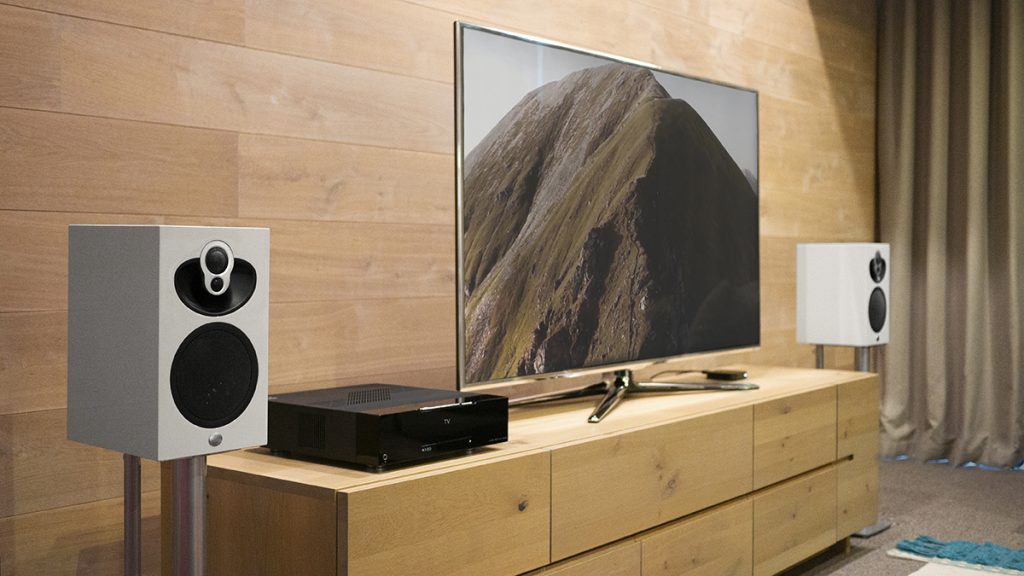
Whenever we think that we have really seen the pinnacle of all-in-one amplifiers, a device pops up that raises the bar in terms of possibilities. Today it’s the turn of the Majik DSM, an entry-level amplifier from Linn that can take on an insane amount of roles. Well, ‘entry’ means something different at Linn than at a mainstream brand … It is immediately clear, this is not a budget device.
The Majik DSM is not a substandard mini amplifier, but a very complete device with a 2 x 100 Watt class D amplification hatch that can also be an end point in terms of hi-fi purchases. Play music from your favorite music service or from vinyl on a connected turntable? Want to hunt the sound of your TV through a set of stereo speakers in high quality? And – unexpectedly with a hi-fi device – be the hub for your game consoles and digital TV decoder? Thanks to the extensive streaming options, phono input, some digital inputs, four HMDI ports / one HDMI-ARC output, and 2 x 100 Watt amplification, the Majik DSM from 3,570 euros can do it all. Linn’s own room correction function is also back.

Linn, who always really does it his way, sees this amplifier potentially as the foundation for a full Linn system. That is why there are also packages in which the Majik DSM is combined with an LP12 turntable and the 109 or 140 speakers of the Scottish brand. Special baseboards and coatings for those speakers are possible, as you would expect from a brand that has always considered customization of paramount importance. The Majik DSM can of course also be used with your own speakers, and that is how we tested the device.
Sleek and modern
We looked up when we plugged in the brand new Majik DSM. It was really a brand new device, just delivered from Glasgow and immediately lent to us by Linn specialist Alex from Concerto Audio in Amsterdam. In the test room, because of that unused status, we were treated to a kind of mini light show in all kinds of bright colors, projected downwards by a series of LEDs that are subtly hidden behind an edge under the screen. It is not now that the room was filled with a huge disco show, but it surprised a moment by its frivolity. We had to think of our built-in dishwasher in a similar way with a light effect on the floor that it is time again to start a discussion within the family about who can unload the thing. Audio reviewers, practice shows, often lose out. The Linn’s light show, however, is a one-off to indicate that the device is being set up for the first time. Once configured, the device will project a thin line of colored light to indicate that it is turned on. By default, this line is blue, but you can also choose a different color via the app. Magenta, green, white or nothing at all (better in darkened TV rooms), whatever you want.

Of course this is a detail, but it does indicate something. Namely, that Linn remains on track to completely modernize its offering. Something that you will also notice in the new app – but more on that in a moment. But let’s talk about that look first. Compared to the previous Majik, the new edition looks a lot more modern. That is a new design direction at the Scots, because the new generation of Linn devices are all a bit more refined and luxurious than their predecessors. We discovered this earlier in the test of the more expensive Selekt, a modular machine that you can use as a pure network player or as an all-in-one amplifier. You don’t have those upgrade options with the Majik. What you buy is what you get.

Roots
It’s a bit difficult to estimate, but Linn’s Scots may have been the first to release a real streamer. That was surprising because so many years ago the company was mainly known for its Sondek LP12 record player – but again no surprise because Linn always attached enormous importance to the place of the source in an audio story. This has to do with the roots of the company, which we found out all about during a factory visit last year .
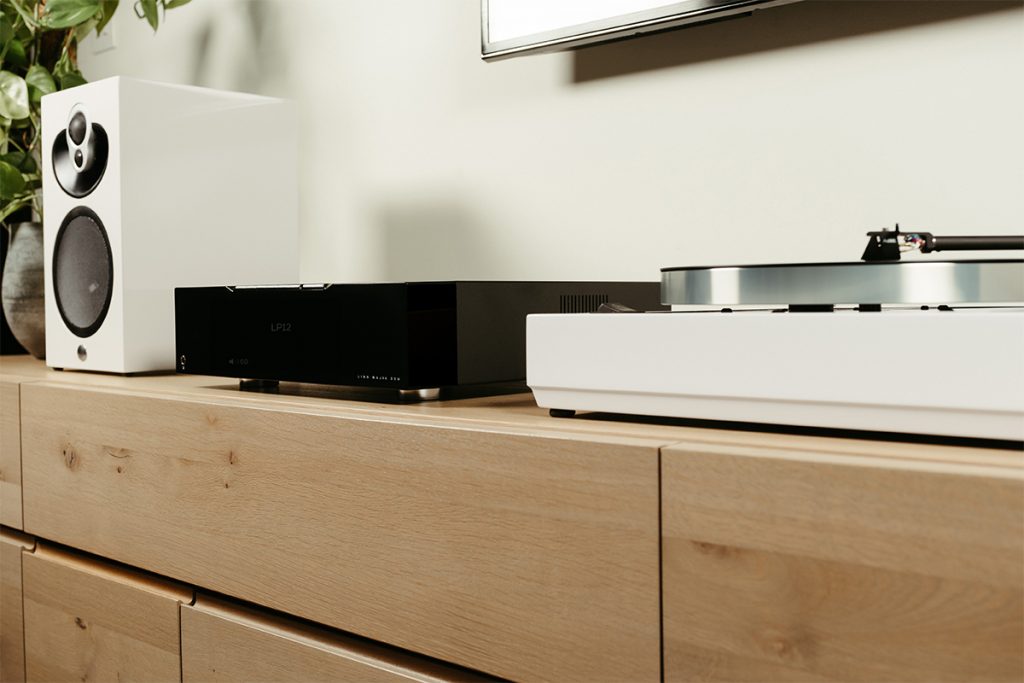
As more and more people listened to music files and streams, the company felt it was time to offer a digital source device in addition to the iconic Sondek and Linn’s then-popular CD players. That very first player was the Klimax DS, followed moments later by the first Majik – the ancestor of the device we are looking at here. This device was revolutionary because it combined streaming with a preamplifier, and could also stream a connected source (a turntable, anyone?) Over the network. Because Linn remains very faithful to a particular model name, the name was also kept for new iterations of the device. So today we come to the Majik DSM 2020, a player that is as versatile as before – what do we say: more versatile – and packed in a housing that in design terms resembles the beautiful Selekt DSM that we have previously tested. The splendor of that more expensive player, which is largely made of glass and aluminum and comes with a mighty volume knob / controller, is hard to match at a much lower price point. But it has to be said: Linn has done his best.
When you see the Majik DSM, you don’t think that there has been a lot of skimping on materials. The clever use of a beautiful plastic makes the facade of the player sober yet eye-catching. When you are listening to music, the entire front presents itself as a black mirrored surface. No seams, no buttons, just a headphone jack in one corner and a very small print brand name in the other corner.
There are buttons on the device, but they are arranged in a beveled edge. And yes, here too Linn is again fully committed to minimalism. There are no function names on the buttons, they present themselves completely unanimously. You quickly learn that six of the seven are ‘pins’, Linn’s name for preset buttons that you can link to a particular music source. An internet radio station, for example, or a playlist for a streaming service. The last button is a volume control. The shiny front panel continues on the sides and top to become a powder coated metal housing.
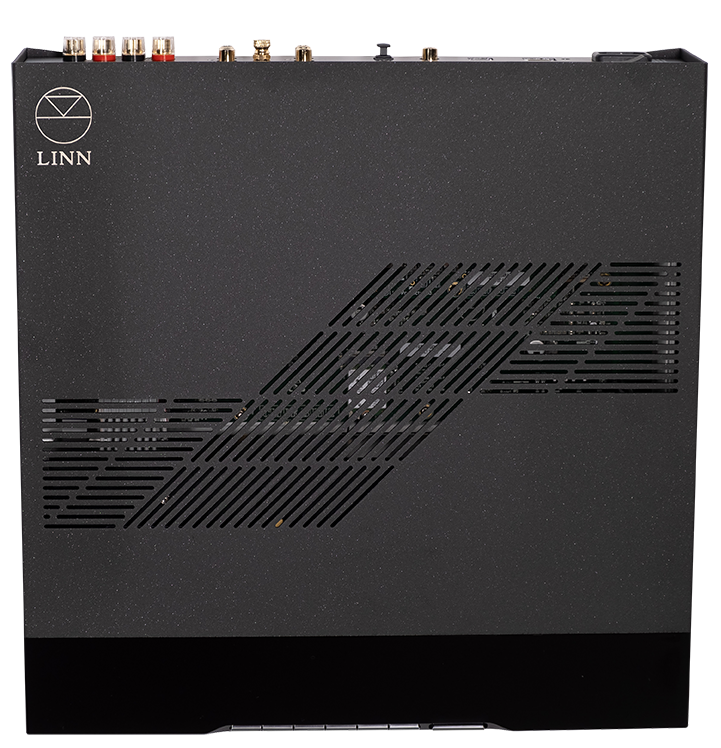
So the device looks very dark and mysterious – until you press a button or stream a song. Then a white on black display behind the front panel lights up, and you get some information about the track or the volume level is shown. Limited, but you can also say: just enough information. And with letters that you can easily read from four meters away.
Fine-tuning
By the way, you can set everything related to the display and the LED indicator via the settings. You do not do this via an app or via the screen on the Majik DSM, but via the browser. No, you shouldn’t start juggling with IP addresses or the like, just log in via the Linn website. Here you will find many options to fine-tune the device to your use. For example, you can turn off sources that you don’t need, so that when you change the input you don’t scroll through a long list of useless options. There are still a lot of useful things, such as the boot volume or which source the Majik DSM will choose first. For tweaking TV sound, there are also necessary features and you can link a number of buttons on the supplied remote to a source of your choice. We find that useful,
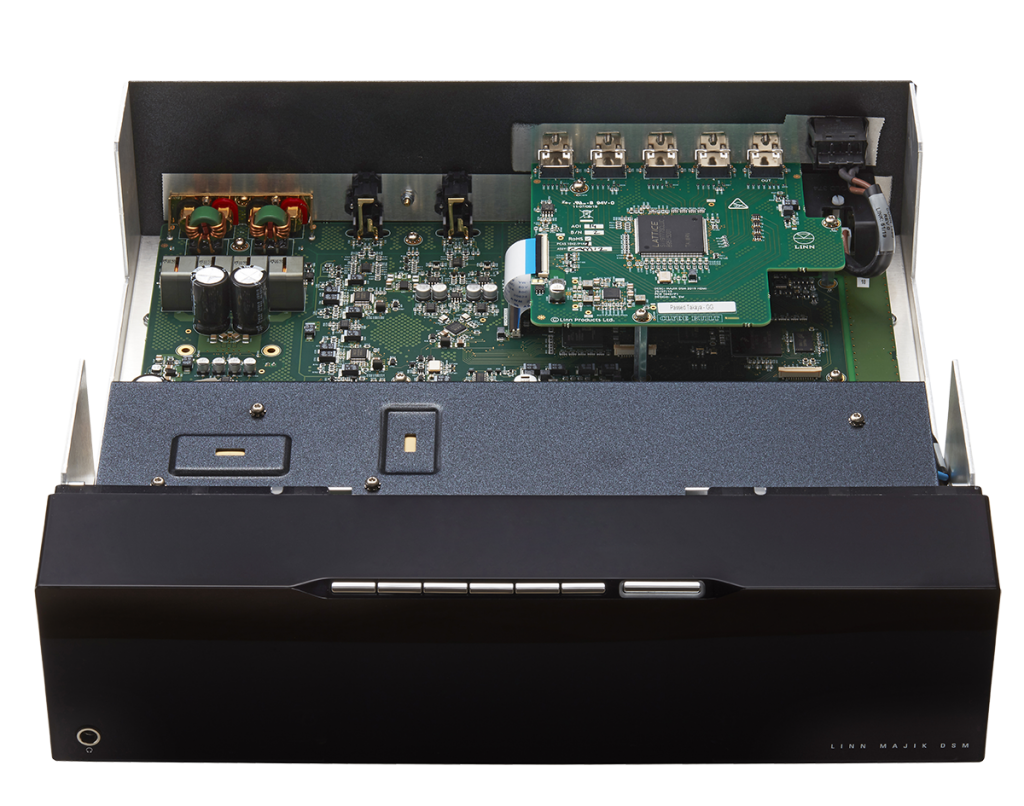
Speaking of adjustability: something that we find very useful with Linn devices are precisely those ‘pins’ or presets. You operate them via the buttons on the device itself, the remote control or via the Linn app. One option is to link a number of presets to specific sources (such as the TV or the turntable), but it is also interesting to give a favorite radio station its own pin, for example.
Go for the iPad
The best partner for a Majik DSM (or a higher model, such as the Selekt) is an iPad. On an iPad or iPhone you can use the new Linn app, which scores very high in terms of looks and ease of use. Simply, it is clear and includes just the functions you need, with the ability to turn off unnecessary sources for an even tighter user experience. Via this app you can choose music on a NAS or via a streaming service (Qobuz and Tidal are supported in the app), with a handy search function to search for music across all streaming sources. We found in testing that the search works fine on its own, but in the case of DLNA shares, the server must support it. We could search on a Minimserver share, but not in a folder shared via the DLNA server baked into a Synology server.

The Linn app (or the older, still available Kazoo app) also contains multiroom options. If you have other Linn devices at home, such as the Series 3 speakers , you can operate them all via the app and link them if desired.

Because Linn builds in the necessary flexibility, there are many other ways to get music from the Majik DSM. When it comes to streaming, you can control the player from Spotify, via a UPnP / DLNA player app, or via AirPlay. Bluetooth is also there. Linn also gets a pat on the back because they immediately ensure full Roon certification, including a modified icon of the player in the program. A compliment is in order, because many manufacturers fail to do so. In addition, there is a line input that you can set as a regular line-in or a phono input (MM).
A small criticism of how Linn handles things concerns the apps and web interfaces. It is clear that the company does not want to leave people who are used to a certain way of working out in the cold. If a new app then appears, the previous one will not be deleted but also kept. In itself that is noble, because why would you as a music lover suddenly have to adjust your working method because a manufacturer wants a different app layout? But you do have to make sure that you use the best and most beautiful way of setting and operating. We would recommend setting Space Optimization via the web interface and not via the older Konfig app.
LINN MAJIK DSM: Stereo for your TV
In one area, this Linn distinguishes itself from almost all comparable all-in-one devices: it also has HDMI inputs. You will still encounter interior-friendly devices with a single HDMI connection, such as the NAD M10 or Lyngdorf TDAI-1120. This allows you to connect the audio device to a TV and send the TV sound through your speakers. The Majik DSM goes a step further by offering four HDMI inputs in addition to that one HDMI-ARC port that you can use to connect consoles or a Blu-ray player. The video part can handle 4K via HDMI 2.0, which is of course a must in 2020. Quite interesting, because thanks to this you can neatly hide all devices in a piece of furniture and only one cable runs to the television on the wall. The Majik DSM therefore resembles an AV receiver in terms of functionality, but is fully focused on stereo reproduction. So anyone looking for a surround experience should look elsewhere, but that’s not what this Linn is all about.

There is nothing difficult about connecting the Linn player to your TV. Within seconds we had laid the cable between the device and the HDMI-ARC input of a Sony KD-65AF9. All we had to do was dive into the TV’s settings to switch the audio output to ‘PCM’. After all, like most stereo solutions, the Majik DSM cannot process Dolby Digital or other surround signal. Given that the end goal is stereo, that’s not a disaster. Thanks to HDMI-ARC, controlling the volume is very easy. You just use the remote of your television or the remote of the Linn. You can also use the Linn app for this task
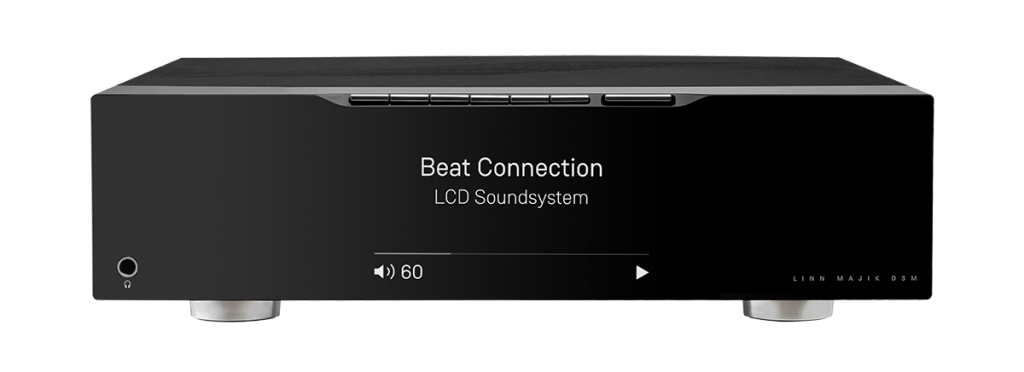
Are you unsure between a stereo solution like this one or a surround setup delivered via a soundbar? The choice will ultimately depend on what is most important to you. A big advantage with something like the Majik DSM is that your music is reproduced correctly and in real stereo through a pair of speakers. It is certainly a superior experience for music. With films and TV series, you may not have the enveloping sound that an (expensive) soundbar can offer you, but you do get a full and dynamic experience in stereo that is much better than what your TV offers. Depending on the speakers you choose, you might even be surprised by how spacious and grand a movie soundtrack can be created by a stereo solution like this. Proper placement of the speakers does play a key role in this.
LINN MAJIK DSM: Adapted to your room
If speakers at home don’t sound like they do in the store, chances are it is due to your room. The shape and dimensions, how the room is decorated and where you place the speakers can have a dramatic impact on the sound reproduction. Since your living room cannot or should not be completely transformed, you have to approach this problem differently: via a room correction function. Software in the amplifier then applies a filter that compensates for the acoustic errors in your room. If a certain bass tone is amplified in your living room, for example because a speaker is close to a corner, then that filter will make that frequency play a bit softer, just to say something. You will find such functions a lot on surround devices and increasingly on stereo devices.
Since Linn likes to Do His Own Thing – you may have already understood that – the Scottish company takes a different approach from rival manufacturers. Where most room correction software starts from one or more measurements with a microphone in your room, Linns Space Optimization works with a model of your room that you enter yourself. You enter the dimensions of your room via the Konfig app or via a slick web interface, where you can also add fine-meshed things like windows, fireplaces and doors. You can also indicate the building materials of walls and floors. Another important element to indicate is where your speakers are and where you listen to music. You hear it: a laser meter is very practical at this point.

Via a graphic menu you can optionally indicate which speakers you will use. You can not only select Linn speakers here, because the list is immense and includes the most famous (and a number of lesser known) speaker builders. A large number of them have been measured by Linn in their lab, which makes Space Optimization more accurate.
Space Optimization will calculate a filter based on all that data. You may like the result immediately, but if you wish, you can then adjust the filter via the web interface, for example if you think that just too few basses have disappeared from the playback. Experimenting is also allowed and part of the fun. There are of course also dealers who can do this for you.
Let’s make it cozy
‘Bass Drum Concerto III’, in which Branford Marsalis performs a composition by Prokofiev with the philharmonic orchestra of the Ural, is something very special to listen to. The work for saxophone and drum bass is a bit nervous in nature, but it is mainly how the sound level is played throughout the four-minute piece that remains fascinating. Percussionist Joby Burgess plays a prominent role in this musical story, a source of all kinds of rhythmic sounds that are sometimes very present, sometimes very subtly woven through the work. In other words, it is an atypically classical composition that loses all impact on a wireless speaker and flourishes in a solid stereo setup. This is why you go for better hi-fi. We note at the Majik DSM that those dynamic jumps are taken without hearing stress, even if we turn the volume knob to a high setting. We are on the DALI Rubicon 2’s still asking something from the Linn engine, but that in itself is not a problem. It all continues to sound very stress-free and pleasant.
The much more difficult to control Bowers & Wilkins 705 Signature stand mounts are also tough but feasible for Linn’s Class D amplifier. In fact, sound-wise we thought that match really worked well. The fresh, revealing character of the British speakers fits well with the musical and warmness of the Scots, a very pleasant listening result in our opinion. Put on ‘Lilies’ by Melanie De Biasio and you’re off for a great listening session.

We always took the trouble to set Space Optimization during the test period, because we already knew from the Selekt review that the function really adds something. Although ‘take away’ might be a better choice of words in this case; it’s resolution and tightness that comes with it. We also set Space Optimization when we rolled our big Focal Sopra N ° 2’s to the listening positions. Speakers that in terms of size (and cost) contrast with the Majik DSM, but again: it’s okay. Every now and then we also added an SVS SB-2000Pro subwoofer to the Majik DSM. Not because it was really necessary; because even powerful speakers like the Focals can get even better with extra sub bass. Well, we think so. The higher goal, however, is to experience whether Space Optimization works equally well with a 2.0 and a 2.1 configuration. After all, two speakers and a subwoofer are an interesting option if you want to use an interior-friendly pair of small bookshelf speakers, and still want to enjoy the necessary bass. In terms of small speakers and if you want to use the Majik DSM as a TV solution, it is even more recommended. The answer to the 2.1 question is in any case ‘yes’.
Conclusion
The Majik DSM has been transformed in its new version into an incredibly versatile device that combines excellent sound quality with just about any streaming function you could wish for. The beautiful minimalist design subtly blends into most interiors, while you can listen to music and TV sound in high quality. You really just need to add speakers to use it.
The concept of an interior-friendly amplifier that does everything is not unique to Linn, of course. The Majik DSM does have its own strengths, such as Space Optimization, the four HDMI inputs and the multiroom functions. Linn also has a reputation for providing long-term support for its products, which gives the Majik DSM 2020 a solid future-proof aura.
PLUS POINTS of LINN MAJIK DSM
- Actually nothing is missing
- Small but brave amp
- Space Optimization
- Phono input and four 4K HDMI inputs
- Excellent Linn app
MINUSES of LINN MAJIK DSM
- Still waiting for new Android app
- Not suitable for Exakt speakers
